Analyzing Cultural Diversity and Team Performance in Saudi Airports
VerifiedAdded on 2023/03/31
|8
|2295
|490
Presentation
AI Summary
This presentation delves into the impact of cultural diversity on team performance, focusing on Saudi airports as a case study. It begins by establishing the candidate's background and the development of the research topic, highlighting Saudi Arabia's economic diversification efforts and its diverse workforce. The presentation explores the importance of teams and diversity in the workplace, referencing existing research on the topic. It emphasizes the empirical focus on Saudi airports, citing the variety of teams and the internationalized labor force as key factors. The research strategy employs mixed methods, utilizing both qualitative and quantitative data collection techniques, with data analysis conducted using SPSS. Ultimately, the presentation aims to provide insights into the relationship between cultural diversity and team performance within the unique context of Saudi airports, offering students access to solved assignments and study resources on Desklib.
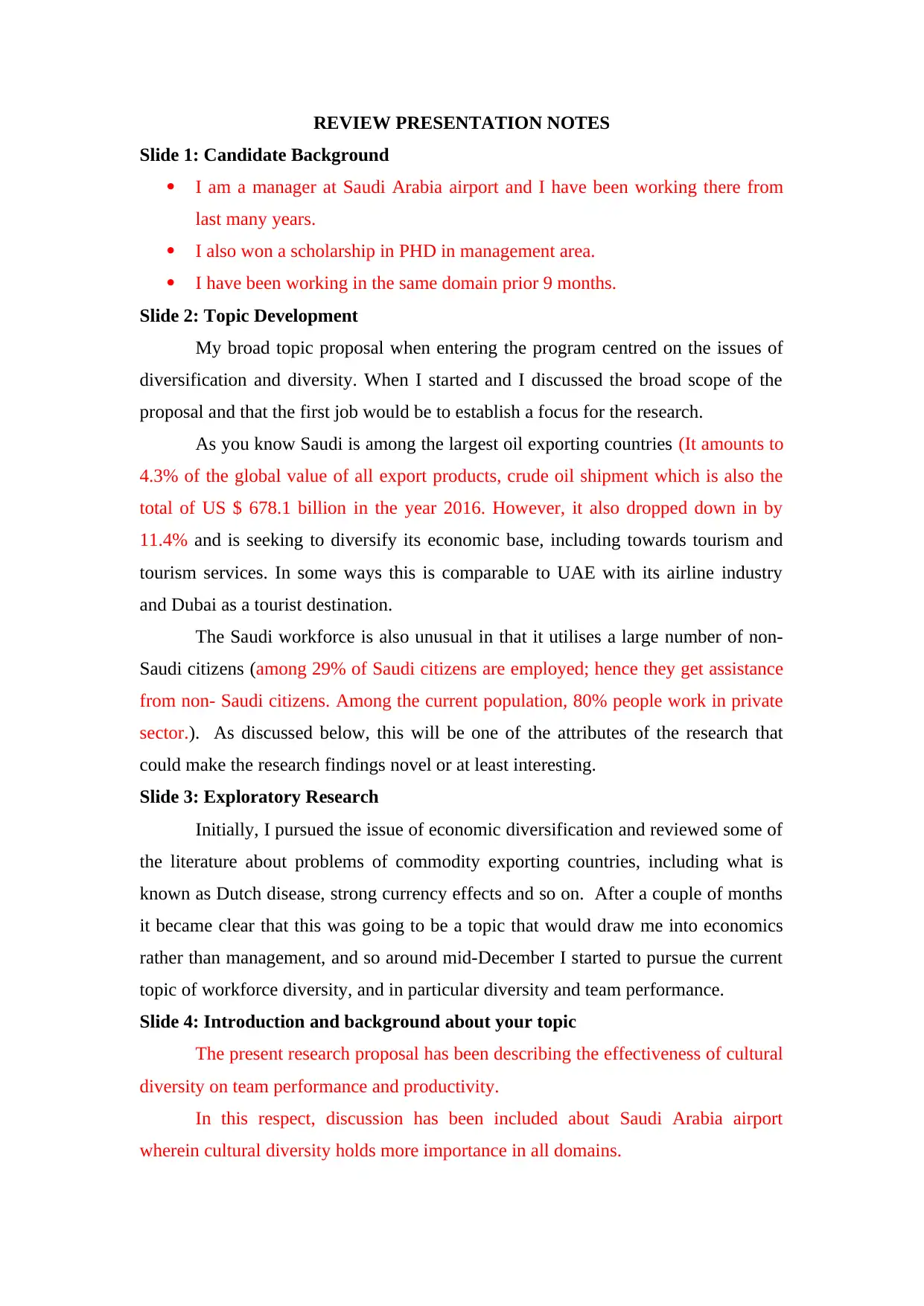
REVIEW PRESENTATION NOTES
Slide 1: Candidate Background
I am a manager at Saudi Arabia airport and I have been working there from
last many years.
I also won a scholarship in PHD in management area.
I have been working in the same domain prior 9 months.
Slide 2: Topic Development
My broad topic proposal when entering the program centred on the issues of
diversification and diversity. When I started and I discussed the broad scope of the
proposal and that the first job would be to establish a focus for the research.
As you know Saudi is among the largest oil exporting countries (It amounts to
4.3% of the global value of all export products, crude oil shipment which is also the
total of US $ 678.1 billion in the year 2016. However, it also dropped down in by
11.4% and is seeking to diversify its economic base, including towards tourism and
tourism services. In some ways this is comparable to UAE with its airline industry
and Dubai as a tourist destination.
The Saudi workforce is also unusual in that it utilises a large number of non-
Saudi citizens (among 29% of Saudi citizens are employed; hence they get assistance
from non- Saudi citizens. Among the current population, 80% people work in private
sector.). As discussed below, this will be one of the attributes of the research that
could make the research findings novel or at least interesting.
Slide 3: Exploratory Research
Initially, I pursued the issue of economic diversification and reviewed some of
the literature about problems of commodity exporting countries, including what is
known as Dutch disease, strong currency effects and so on. After a couple of months
it became clear that this was going to be a topic that would draw me into economics
rather than management, and so around mid-December I started to pursue the current
topic of workforce diversity, and in particular diversity and team performance.
Slide 4: Introduction and background about your topic
The present research proposal has been describing the effectiveness of cultural
diversity on team performance and productivity.
In this respect, discussion has been included about Saudi Arabia airport
wherein cultural diversity holds more importance in all domains.
Slide 1: Candidate Background
I am a manager at Saudi Arabia airport and I have been working there from
last many years.
I also won a scholarship in PHD in management area.
I have been working in the same domain prior 9 months.
Slide 2: Topic Development
My broad topic proposal when entering the program centred on the issues of
diversification and diversity. When I started and I discussed the broad scope of the
proposal and that the first job would be to establish a focus for the research.
As you know Saudi is among the largest oil exporting countries (It amounts to
4.3% of the global value of all export products, crude oil shipment which is also the
total of US $ 678.1 billion in the year 2016. However, it also dropped down in by
11.4% and is seeking to diversify its economic base, including towards tourism and
tourism services. In some ways this is comparable to UAE with its airline industry
and Dubai as a tourist destination.
The Saudi workforce is also unusual in that it utilises a large number of non-
Saudi citizens (among 29% of Saudi citizens are employed; hence they get assistance
from non- Saudi citizens. Among the current population, 80% people work in private
sector.). As discussed below, this will be one of the attributes of the research that
could make the research findings novel or at least interesting.
Slide 3: Exploratory Research
Initially, I pursued the issue of economic diversification and reviewed some of
the literature about problems of commodity exporting countries, including what is
known as Dutch disease, strong currency effects and so on. After a couple of months
it became clear that this was going to be a topic that would draw me into economics
rather than management, and so around mid-December I started to pursue the current
topic of workforce diversity, and in particular diversity and team performance.
Slide 4: Introduction and background about your topic
The present research proposal has been describing the effectiveness of cultural
diversity on team performance and productivity.
In this respect, discussion has been included about Saudi Arabia airport
wherein cultural diversity holds more importance in all domains.
Paraphrase This Document
Need a fresh take? Get an instant paraphrase of this document with our AI Paraphraser
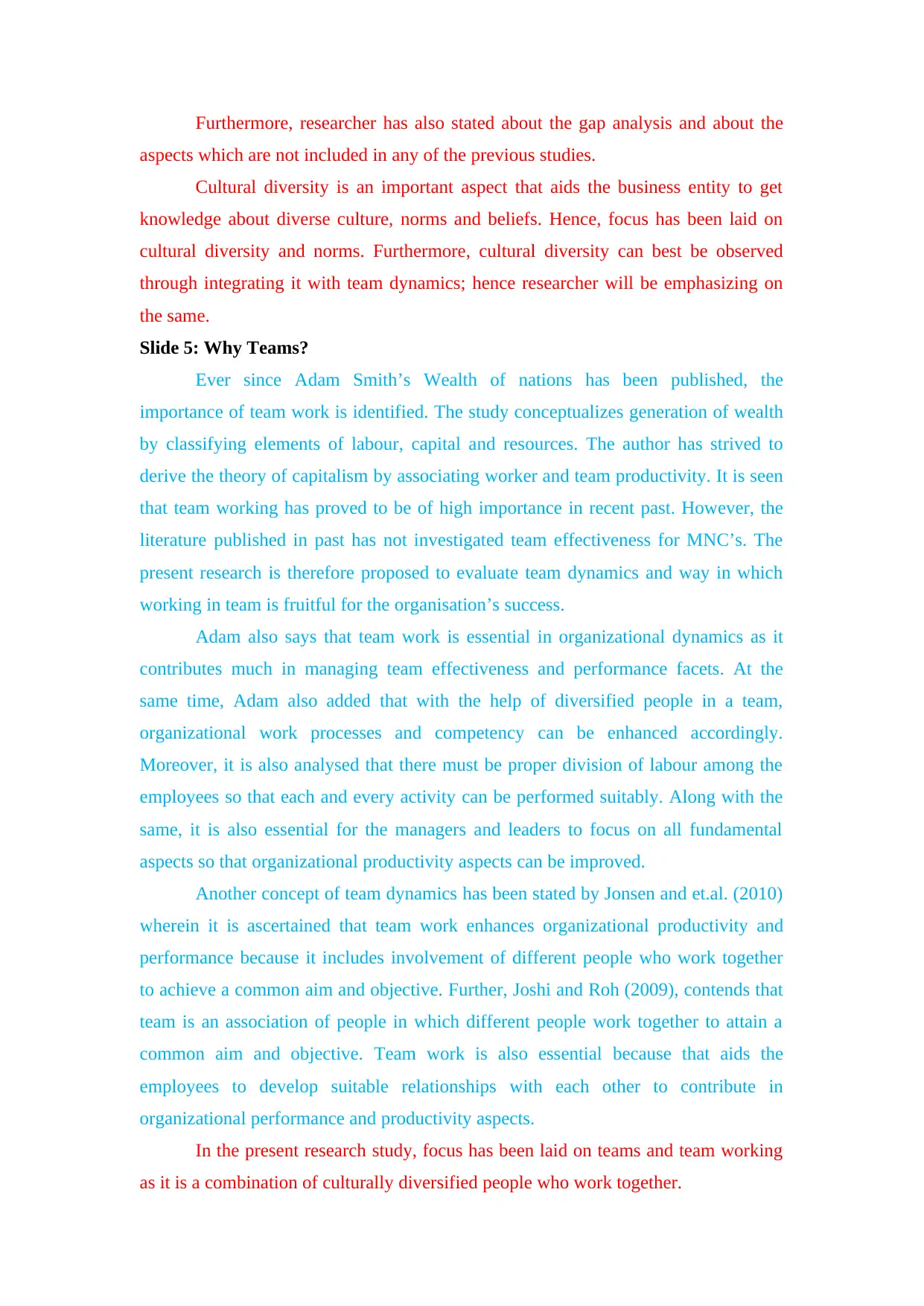
Furthermore, researcher has also stated about the gap analysis and about the
aspects which are not included in any of the previous studies.
Cultural diversity is an important aspect that aids the business entity to get
knowledge about diverse culture, norms and beliefs. Hence, focus has been laid on
cultural diversity and norms. Furthermore, cultural diversity can best be observed
through integrating it with team dynamics; hence researcher will be emphasizing on
the same.
Slide 5: Why Teams?
Ever since Adam Smith’s Wealth of nations has been published, the
importance of team work is identified. The study conceptualizes generation of wealth
by classifying elements of labour, capital and resources. The author has strived to
derive the theory of capitalism by associating worker and team productivity. It is seen
that team working has proved to be of high importance in recent past. However, the
literature published in past has not investigated team effectiveness for MNC’s. The
present research is therefore proposed to evaluate team dynamics and way in which
working in team is fruitful for the organisation’s success.
Adam also says that team work is essential in organizational dynamics as it
contributes much in managing team effectiveness and performance facets. At the
same time, Adam also added that with the help of diversified people in a team,
organizational work processes and competency can be enhanced accordingly.
Moreover, it is also analysed that there must be proper division of labour among the
employees so that each and every activity can be performed suitably. Along with the
same, it is also essential for the managers and leaders to focus on all fundamental
aspects so that organizational productivity aspects can be improved.
Another concept of team dynamics has been stated by Jonsen and et.al. (2010)
wherein it is ascertained that team work enhances organizational productivity and
performance because it includes involvement of different people who work together
to achieve a common aim and objective. Further, Joshi and Roh (2009), contends that
team is an association of people in which different people work together to attain a
common aim and objective. Team work is also essential because that aids the
employees to develop suitable relationships with each other to contribute in
organizational performance and productivity aspects.
In the present research study, focus has been laid on teams and team working
as it is a combination of culturally diversified people who work together.
aspects which are not included in any of the previous studies.
Cultural diversity is an important aspect that aids the business entity to get
knowledge about diverse culture, norms and beliefs. Hence, focus has been laid on
cultural diversity and norms. Furthermore, cultural diversity can best be observed
through integrating it with team dynamics; hence researcher will be emphasizing on
the same.
Slide 5: Why Teams?
Ever since Adam Smith’s Wealth of nations has been published, the
importance of team work is identified. The study conceptualizes generation of wealth
by classifying elements of labour, capital and resources. The author has strived to
derive the theory of capitalism by associating worker and team productivity. It is seen
that team working has proved to be of high importance in recent past. However, the
literature published in past has not investigated team effectiveness for MNC’s. The
present research is therefore proposed to evaluate team dynamics and way in which
working in team is fruitful for the organisation’s success.
Adam also says that team work is essential in organizational dynamics as it
contributes much in managing team effectiveness and performance facets. At the
same time, Adam also added that with the help of diversified people in a team,
organizational work processes and competency can be enhanced accordingly.
Moreover, it is also analysed that there must be proper division of labour among the
employees so that each and every activity can be performed suitably. Along with the
same, it is also essential for the managers and leaders to focus on all fundamental
aspects so that organizational productivity aspects can be improved.
Another concept of team dynamics has been stated by Jonsen and et.al. (2010)
wherein it is ascertained that team work enhances organizational productivity and
performance because it includes involvement of different people who work together
to achieve a common aim and objective. Further, Joshi and Roh (2009), contends that
team is an association of people in which different people work together to attain a
common aim and objective. Team work is also essential because that aids the
employees to develop suitable relationships with each other to contribute in
organizational performance and productivity aspects.
In the present research study, focus has been laid on teams and team working
as it is a combination of culturally diversified people who work together.
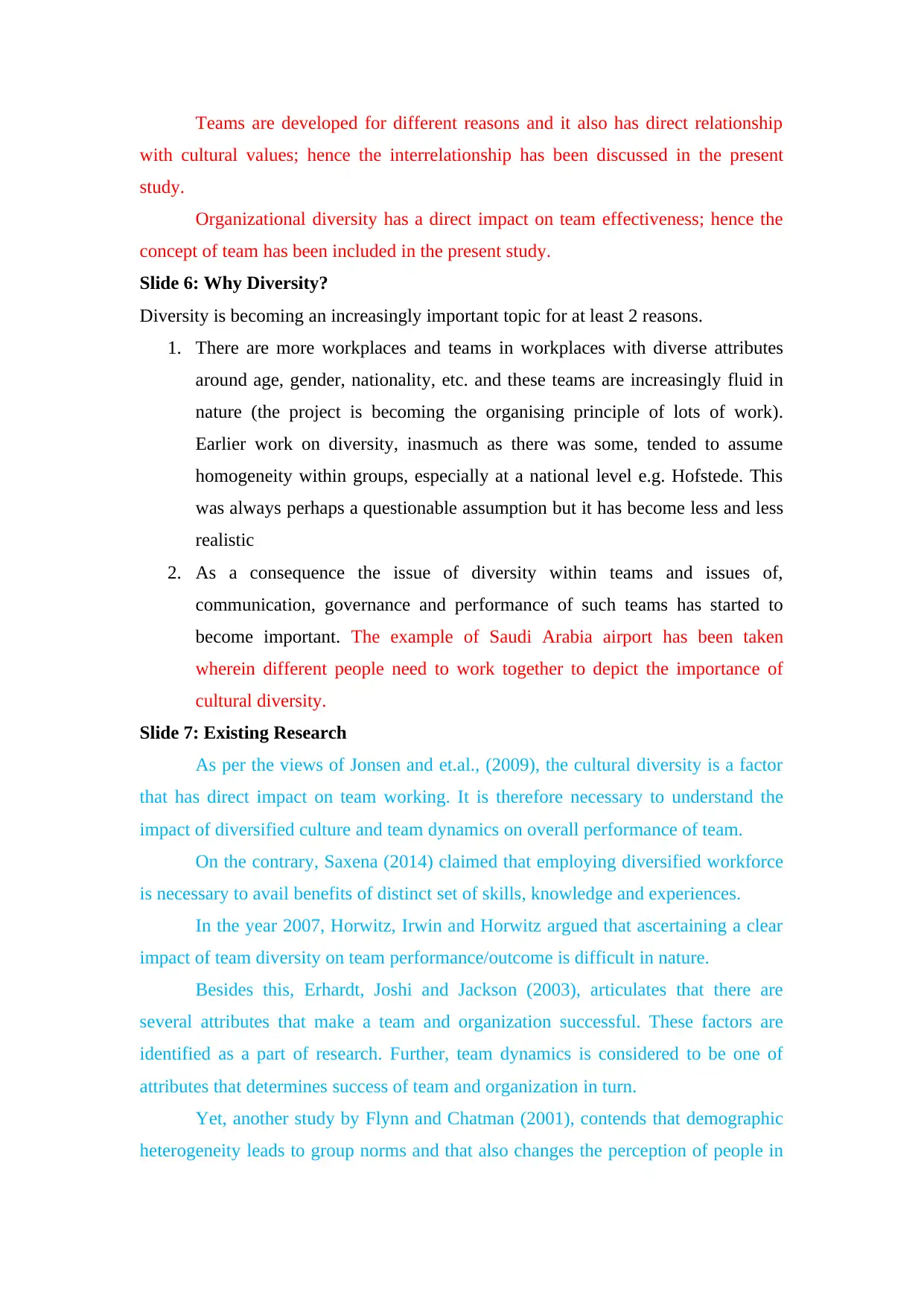
Teams are developed for different reasons and it also has direct relationship
with cultural values; hence the interrelationship has been discussed in the present
study.
Organizational diversity has a direct impact on team effectiveness; hence the
concept of team has been included in the present study.
Slide 6: Why Diversity?
Diversity is becoming an increasingly important topic for at least 2 reasons.
1. There are more workplaces and teams in workplaces with diverse attributes
around age, gender, nationality, etc. and these teams are increasingly fluid in
nature (the project is becoming the organising principle of lots of work).
Earlier work on diversity, inasmuch as there was some, tended to assume
homogeneity within groups, especially at a national level e.g. Hofstede. This
was always perhaps a questionable assumption but it has become less and less
realistic
2. As a consequence the issue of diversity within teams and issues of,
communication, governance and performance of such teams has started to
become important. The example of Saudi Arabia airport has been taken
wherein different people need to work together to depict the importance of
cultural diversity.
Slide 7: Existing Research
As per the views of Jonsen and et.al., (2009), the cultural diversity is a factor
that has direct impact on team working. It is therefore necessary to understand the
impact of diversified culture and team dynamics on overall performance of team.
On the contrary, Saxena (2014) claimed that employing diversified workforce
is necessary to avail benefits of distinct set of skills, knowledge and experiences.
In the year 2007, Horwitz, Irwin and Horwitz argued that ascertaining a clear
impact of team diversity on team performance/outcome is difficult in nature.
Besides this, Erhardt, Joshi and Jackson (2003), articulates that there are
several attributes that make a team and organization successful. These factors are
identified as a part of research. Further, team dynamics is considered to be one of
attributes that determines success of team and organization in turn.
Yet, another study by Flynn and Chatman (2001), contends that demographic
heterogeneity leads to group norms and that also changes the perception of people in
with cultural values; hence the interrelationship has been discussed in the present
study.
Organizational diversity has a direct impact on team effectiveness; hence the
concept of team has been included in the present study.
Slide 6: Why Diversity?
Diversity is becoming an increasingly important topic for at least 2 reasons.
1. There are more workplaces and teams in workplaces with diverse attributes
around age, gender, nationality, etc. and these teams are increasingly fluid in
nature (the project is becoming the organising principle of lots of work).
Earlier work on diversity, inasmuch as there was some, tended to assume
homogeneity within groups, especially at a national level e.g. Hofstede. This
was always perhaps a questionable assumption but it has become less and less
realistic
2. As a consequence the issue of diversity within teams and issues of,
communication, governance and performance of such teams has started to
become important. The example of Saudi Arabia airport has been taken
wherein different people need to work together to depict the importance of
cultural diversity.
Slide 7: Existing Research
As per the views of Jonsen and et.al., (2009), the cultural diversity is a factor
that has direct impact on team working. It is therefore necessary to understand the
impact of diversified culture and team dynamics on overall performance of team.
On the contrary, Saxena (2014) claimed that employing diversified workforce
is necessary to avail benefits of distinct set of skills, knowledge and experiences.
In the year 2007, Horwitz, Irwin and Horwitz argued that ascertaining a clear
impact of team diversity on team performance/outcome is difficult in nature.
Besides this, Erhardt, Joshi and Jackson (2003), articulates that there are
several attributes that make a team and organization successful. These factors are
identified as a part of research. Further, team dynamics is considered to be one of
attributes that determines success of team and organization in turn.
Yet, another study by Flynn and Chatman (2001), contends that demographic
heterogeneity leads to group norms and that also changes the perception of people in
⊘ This is a preview!⊘
Do you want full access?
Subscribe today to unlock all pages.

Trusted by 1+ million students worldwide
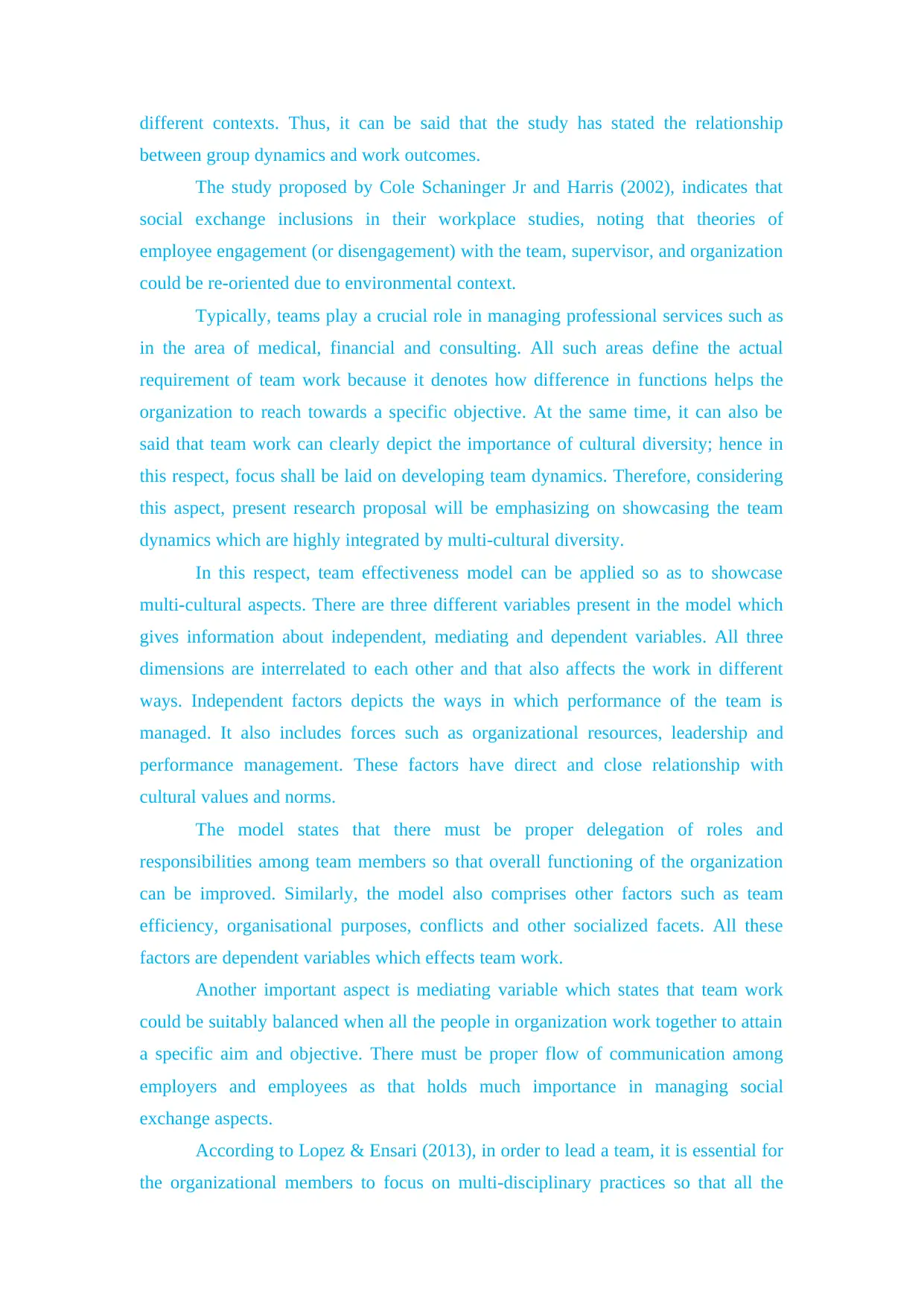
different contexts. Thus, it can be said that the study has stated the relationship
between group dynamics and work outcomes.
The study proposed by Cole Schaninger Jr and Harris (2002), indicates that
social exchange inclusions in their workplace studies, noting that theories of
employee engagement (or disengagement) with the team, supervisor, and organization
could be re-oriented due to environmental context.
Typically, teams play a crucial role in managing professional services such as
in the area of medical, financial and consulting. All such areas define the actual
requirement of team work because it denotes how difference in functions helps the
organization to reach towards a specific objective. At the same time, it can also be
said that team work can clearly depict the importance of cultural diversity; hence in
this respect, focus shall be laid on developing team dynamics. Therefore, considering
this aspect, present research proposal will be emphasizing on showcasing the team
dynamics which are highly integrated by multi-cultural diversity.
In this respect, team effectiveness model can be applied so as to showcase
multi-cultural aspects. There are three different variables present in the model which
gives information about independent, mediating and dependent variables. All three
dimensions are interrelated to each other and that also affects the work in different
ways. Independent factors depicts the ways in which performance of the team is
managed. It also includes forces such as organizational resources, leadership and
performance management. These factors have direct and close relationship with
cultural values and norms.
The model states that there must be proper delegation of roles and
responsibilities among team members so that overall functioning of the organization
can be improved. Similarly, the model also comprises other factors such as team
efficiency, organisational purposes, conflicts and other socialized facets. All these
factors are dependent variables which effects team work.
Another important aspect is mediating variable which states that team work
could be suitably balanced when all the people in organization work together to attain
a specific aim and objective. There must be proper flow of communication among
employers and employees as that holds much importance in managing social
exchange aspects.
According to Lopez & Ensari (2013), in order to lead a team, it is essential for
the organizational members to focus on multi-disciplinary practices so that all the
between group dynamics and work outcomes.
The study proposed by Cole Schaninger Jr and Harris (2002), indicates that
social exchange inclusions in their workplace studies, noting that theories of
employee engagement (or disengagement) with the team, supervisor, and organization
could be re-oriented due to environmental context.
Typically, teams play a crucial role in managing professional services such as
in the area of medical, financial and consulting. All such areas define the actual
requirement of team work because it denotes how difference in functions helps the
organization to reach towards a specific objective. At the same time, it can also be
said that team work can clearly depict the importance of cultural diversity; hence in
this respect, focus shall be laid on developing team dynamics. Therefore, considering
this aspect, present research proposal will be emphasizing on showcasing the team
dynamics which are highly integrated by multi-cultural diversity.
In this respect, team effectiveness model can be applied so as to showcase
multi-cultural aspects. There are three different variables present in the model which
gives information about independent, mediating and dependent variables. All three
dimensions are interrelated to each other and that also affects the work in different
ways. Independent factors depicts the ways in which performance of the team is
managed. It also includes forces such as organizational resources, leadership and
performance management. These factors have direct and close relationship with
cultural values and norms.
The model states that there must be proper delegation of roles and
responsibilities among team members so that overall functioning of the organization
can be improved. Similarly, the model also comprises other factors such as team
efficiency, organisational purposes, conflicts and other socialized facets. All these
factors are dependent variables which effects team work.
Another important aspect is mediating variable which states that team work
could be suitably balanced when all the people in organization work together to attain
a specific aim and objective. There must be proper flow of communication among
employers and employees as that holds much importance in managing social
exchange aspects.
According to Lopez & Ensari (2013), in order to lead a team, it is essential for
the organizational members to focus on multi-disciplinary practices so that all the
Paraphrase This Document
Need a fresh take? Get an instant paraphrase of this document with our AI Paraphraser
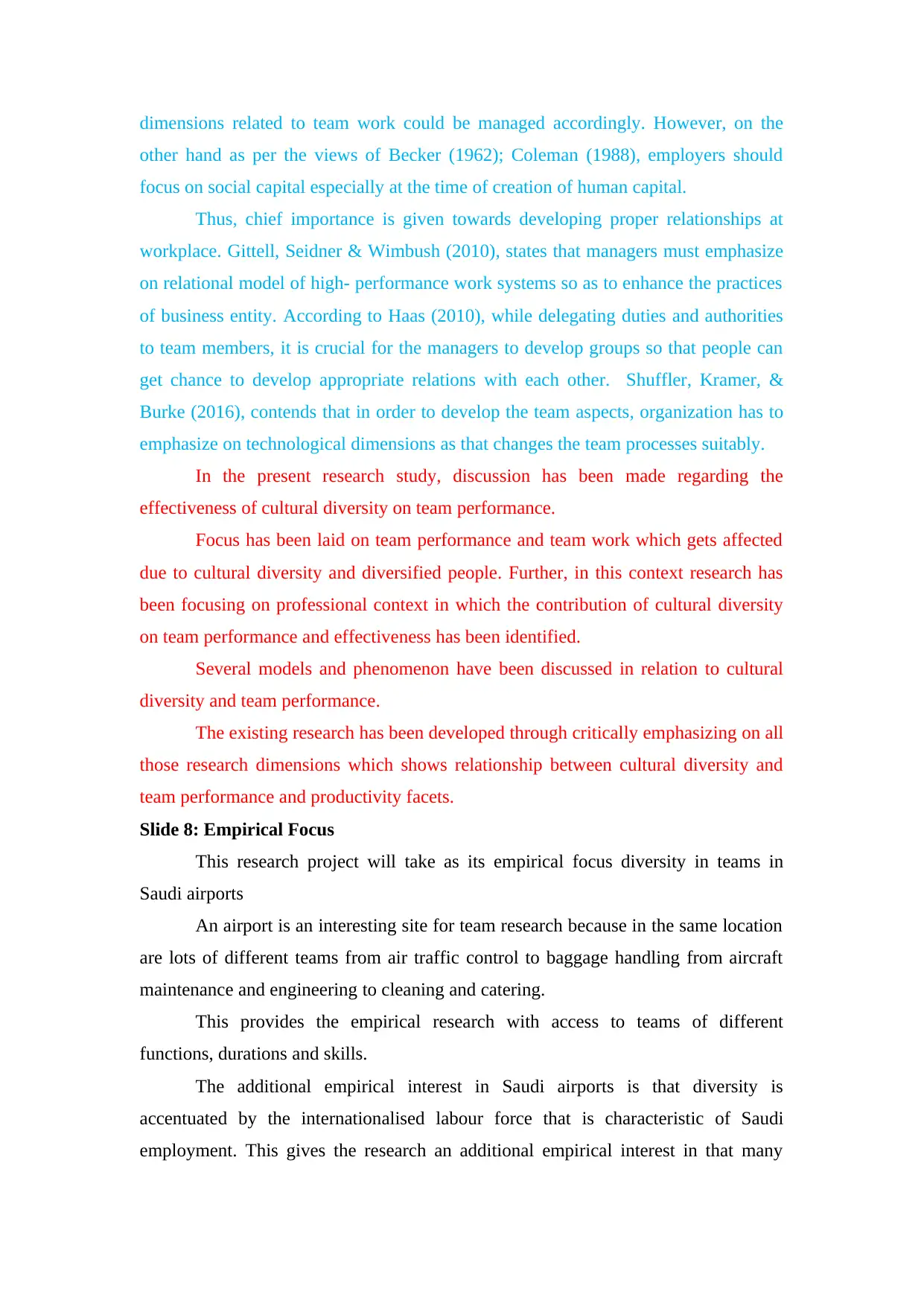
dimensions related to team work could be managed accordingly. However, on the
other hand as per the views of Becker (1962); Coleman (1988), employers should
focus on social capital especially at the time of creation of human capital.
Thus, chief importance is given towards developing proper relationships at
workplace. Gittell, Seidner & Wimbush (2010), states that managers must emphasize
on relational model of high- performance work systems so as to enhance the practices
of business entity. According to Haas (2010), while delegating duties and authorities
to team members, it is crucial for the managers to develop groups so that people can
get chance to develop appropriate relations with each other. Shuffler, Kramer, &
Burke (2016), contends that in order to develop the team aspects, organization has to
emphasize on technological dimensions as that changes the team processes suitably.
In the present research study, discussion has been made regarding the
effectiveness of cultural diversity on team performance.
Focus has been laid on team performance and team work which gets affected
due to cultural diversity and diversified people. Further, in this context research has
been focusing on professional context in which the contribution of cultural diversity
on team performance and effectiveness has been identified.
Several models and phenomenon have been discussed in relation to cultural
diversity and team performance.
The existing research has been developed through critically emphasizing on all
those research dimensions which shows relationship between cultural diversity and
team performance and productivity facets.
Slide 8: Empirical Focus
This research project will take as its empirical focus diversity in teams in
Saudi airports
An airport is an interesting site for team research because in the same location
are lots of different teams from air traffic control to baggage handling from aircraft
maintenance and engineering to cleaning and catering.
This provides the empirical research with access to teams of different
functions, durations and skills.
The additional empirical interest in Saudi airports is that diversity is
accentuated by the internationalised labour force that is characteristic of Saudi
employment. This gives the research an additional empirical interest in that many
other hand as per the views of Becker (1962); Coleman (1988), employers should
focus on social capital especially at the time of creation of human capital.
Thus, chief importance is given towards developing proper relationships at
workplace. Gittell, Seidner & Wimbush (2010), states that managers must emphasize
on relational model of high- performance work systems so as to enhance the practices
of business entity. According to Haas (2010), while delegating duties and authorities
to team members, it is crucial for the managers to develop groups so that people can
get chance to develop appropriate relations with each other. Shuffler, Kramer, &
Burke (2016), contends that in order to develop the team aspects, organization has to
emphasize on technological dimensions as that changes the team processes suitably.
In the present research study, discussion has been made regarding the
effectiveness of cultural diversity on team performance.
Focus has been laid on team performance and team work which gets affected
due to cultural diversity and diversified people. Further, in this context research has
been focusing on professional context in which the contribution of cultural diversity
on team performance and effectiveness has been identified.
Several models and phenomenon have been discussed in relation to cultural
diversity and team performance.
The existing research has been developed through critically emphasizing on all
those research dimensions which shows relationship between cultural diversity and
team performance and productivity facets.
Slide 8: Empirical Focus
This research project will take as its empirical focus diversity in teams in
Saudi airports
An airport is an interesting site for team research because in the same location
are lots of different teams from air traffic control to baggage handling from aircraft
maintenance and engineering to cleaning and catering.
This provides the empirical research with access to teams of different
functions, durations and skills.
The additional empirical interest in Saudi airports is that diversity is
accentuated by the internationalised labour force that is characteristic of Saudi
employment. This gives the research an additional empirical interest in that many
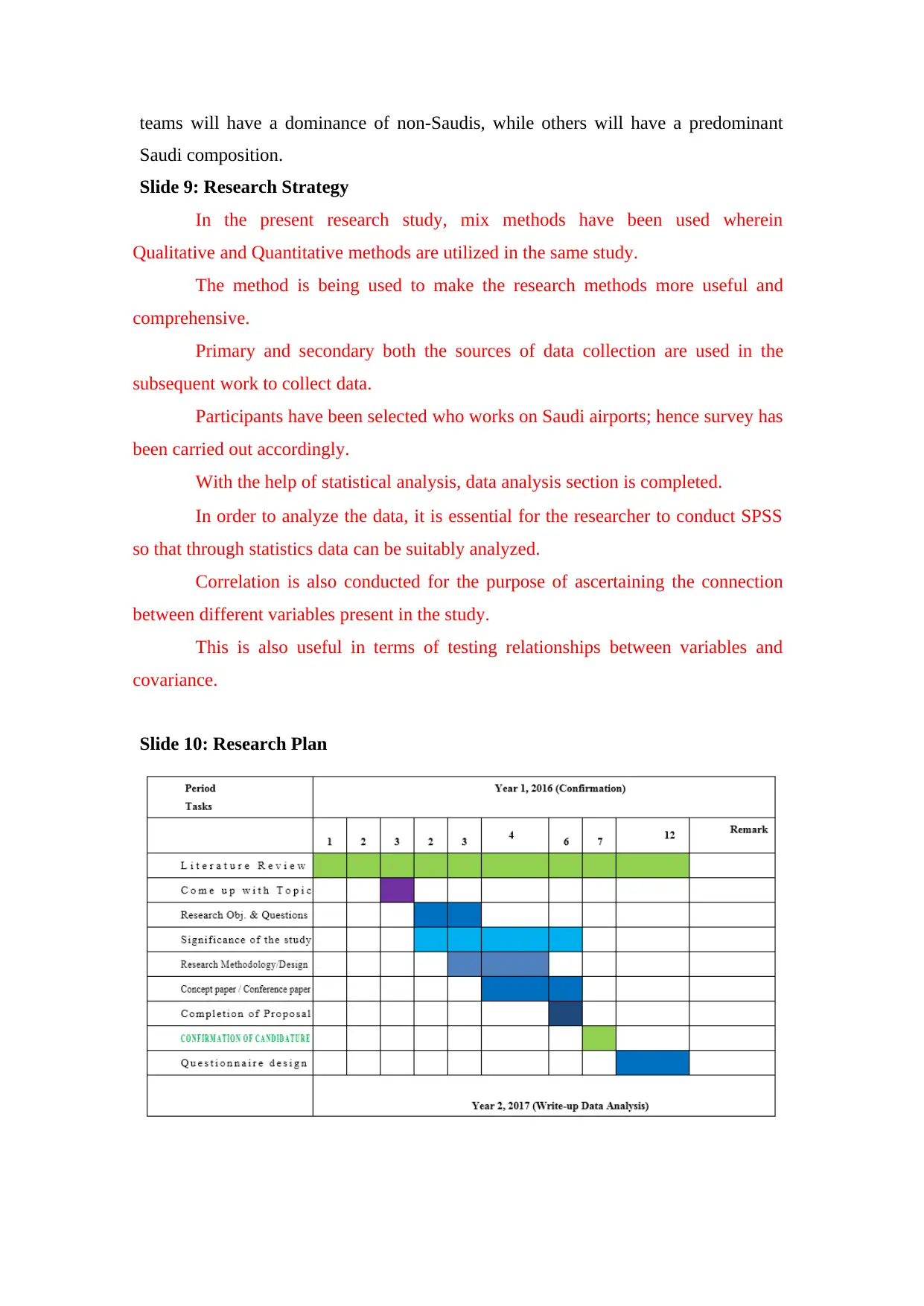
teams will have a dominance of non-Saudis, while others will have a predominant
Saudi composition.
Slide 9: Research Strategy
In the present research study, mix methods have been used wherein
Qualitative and Quantitative methods are utilized in the same study.
The method is being used to make the research methods more useful and
comprehensive.
Primary and secondary both the sources of data collection are used in the
subsequent work to collect data.
Participants have been selected who works on Saudi airports; hence survey has
been carried out accordingly.
With the help of statistical analysis, data analysis section is completed.
In order to analyze the data, it is essential for the researcher to conduct SPSS
so that through statistics data can be suitably analyzed.
Correlation is also conducted for the purpose of ascertaining the connection
between different variables present in the study.
This is also useful in terms of testing relationships between variables and
covariance.
Slide 10: Research Plan
Saudi composition.
Slide 9: Research Strategy
In the present research study, mix methods have been used wherein
Qualitative and Quantitative methods are utilized in the same study.
The method is being used to make the research methods more useful and
comprehensive.
Primary and secondary both the sources of data collection are used in the
subsequent work to collect data.
Participants have been selected who works on Saudi airports; hence survey has
been carried out accordingly.
With the help of statistical analysis, data analysis section is completed.
In order to analyze the data, it is essential for the researcher to conduct SPSS
so that through statistics data can be suitably analyzed.
Correlation is also conducted for the purpose of ascertaining the connection
between different variables present in the study.
This is also useful in terms of testing relationships between variables and
covariance.
Slide 10: Research Plan
⊘ This is a preview!⊘
Do you want full access?
Subscribe today to unlock all pages.

Trusted by 1+ million students worldwide
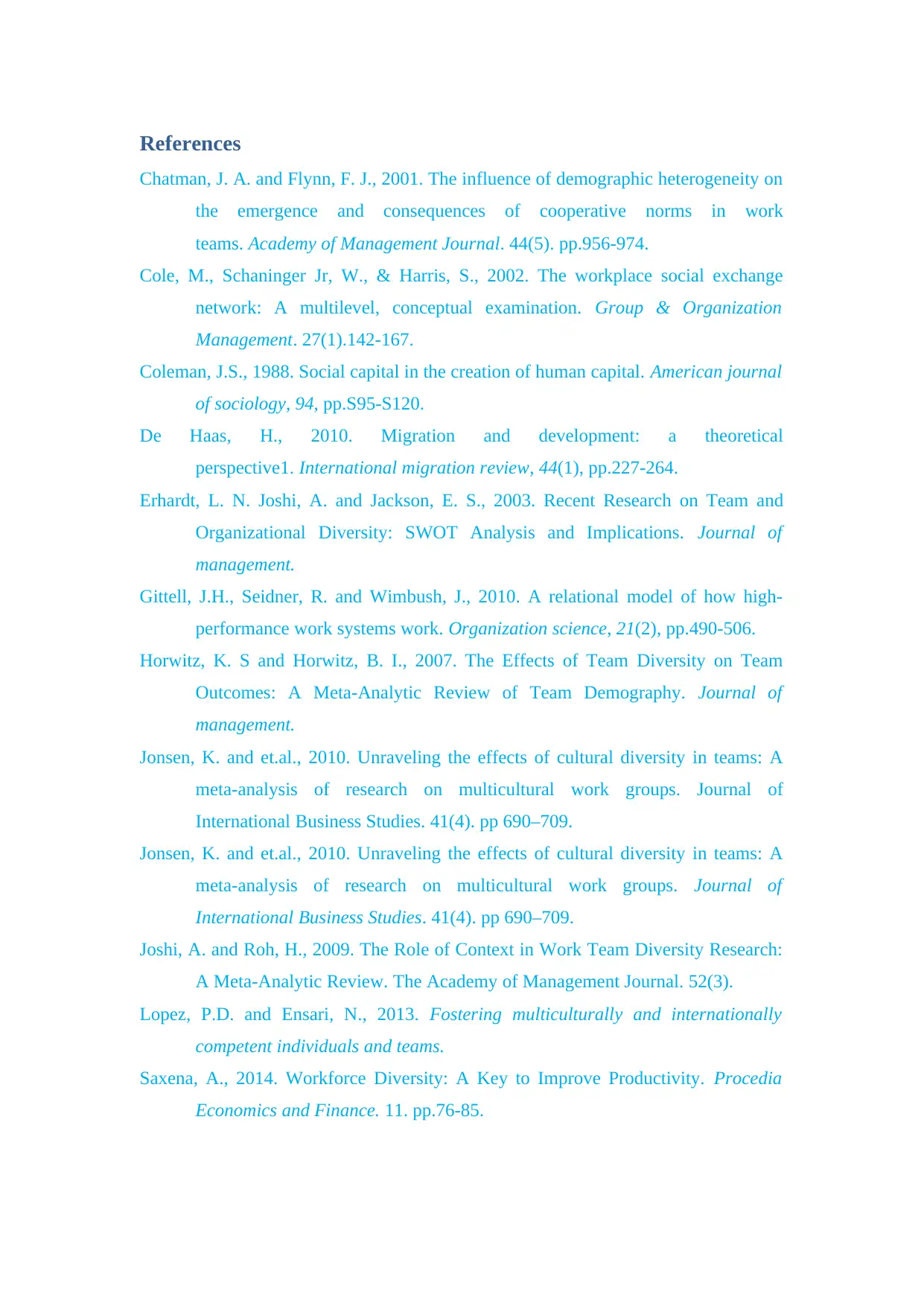
References
Chatman, J. A. and Flynn, F. J., 2001. The influence of demographic heterogeneity on
the emergence and consequences of cooperative norms in work
teams. Academy of Management Journal. 44(5). pp.956-974.
Cole, M., Schaninger Jr, W., & Harris, S., 2002. The workplace social exchange
network: A multilevel, conceptual examination. Group & Organization
Management. 27(1).142-167.
Coleman, J.S., 1988. Social capital in the creation of human capital. American journal
of sociology, 94, pp.S95-S120.
De Haas, H., 2010. Migration and development: a theoretical
perspective1. International migration review, 44(1), pp.227-264.
Erhardt, L. N. Joshi, A. and Jackson, E. S., 2003. Recent Research on Team and
Organizational Diversity: SWOT Analysis and Implications. Journal of
management.
Gittell, J.H., Seidner, R. and Wimbush, J., 2010. A relational model of how high-
performance work systems work. Organization science, 21(2), pp.490-506.
Horwitz, K. S and Horwitz, B. I., 2007. The Effects of Team Diversity on Team
Outcomes: A Meta-Analytic Review of Team Demography. Journal of
management.
Jonsen, K. and et.al., 2010. Unraveling the effects of cultural diversity in teams: A
meta-analysis of research on multicultural work groups. Journal of
International Business Studies. 41(4). pp 690–709.
Jonsen, K. and et.al., 2010. Unraveling the effects of cultural diversity in teams: A
meta-analysis of research on multicultural work groups. Journal of
International Business Studies. 41(4). pp 690–709.
Joshi, A. and Roh, H., 2009. The Role of Context in Work Team Diversity Research:
A Meta-Analytic Review. The Academy of Management Journal. 52(3).
Lopez, P.D. and Ensari, N., 2013. Fostering multiculturally and internationally
competent individuals and teams.
Saxena, A., 2014. Workforce Diversity: A Key to Improve Productivity. Procedia
Economics and Finance. 11. pp.76-85.
Chatman, J. A. and Flynn, F. J., 2001. The influence of demographic heterogeneity on
the emergence and consequences of cooperative norms in work
teams. Academy of Management Journal. 44(5). pp.956-974.
Cole, M., Schaninger Jr, W., & Harris, S., 2002. The workplace social exchange
network: A multilevel, conceptual examination. Group & Organization
Management. 27(1).142-167.
Coleman, J.S., 1988. Social capital in the creation of human capital. American journal
of sociology, 94, pp.S95-S120.
De Haas, H., 2010. Migration and development: a theoretical
perspective1. International migration review, 44(1), pp.227-264.
Erhardt, L. N. Joshi, A. and Jackson, E. S., 2003. Recent Research on Team and
Organizational Diversity: SWOT Analysis and Implications. Journal of
management.
Gittell, J.H., Seidner, R. and Wimbush, J., 2010. A relational model of how high-
performance work systems work. Organization science, 21(2), pp.490-506.
Horwitz, K. S and Horwitz, B. I., 2007. The Effects of Team Diversity on Team
Outcomes: A Meta-Analytic Review of Team Demography. Journal of
management.
Jonsen, K. and et.al., 2010. Unraveling the effects of cultural diversity in teams: A
meta-analysis of research on multicultural work groups. Journal of
International Business Studies. 41(4). pp 690–709.
Jonsen, K. and et.al., 2010. Unraveling the effects of cultural diversity in teams: A
meta-analysis of research on multicultural work groups. Journal of
International Business Studies. 41(4). pp 690–709.
Joshi, A. and Roh, H., 2009. The Role of Context in Work Team Diversity Research:
A Meta-Analytic Review. The Academy of Management Journal. 52(3).
Lopez, P.D. and Ensari, N., 2013. Fostering multiculturally and internationally
competent individuals and teams.
Saxena, A., 2014. Workforce Diversity: A Key to Improve Productivity. Procedia
Economics and Finance. 11. pp.76-85.
Paraphrase This Document
Need a fresh take? Get an instant paraphrase of this document with our AI Paraphraser

Shuffler, M.L., Kramer, W.S. and Burke, C.S., 2016. # TeamLeadership: Leadership
for Today’s Multicultural, Virtual, and Distributed Teams. In Critical Issues
in Cross Cultural Management (pp. 1-14). Springer International Publishing.
for Today’s Multicultural, Virtual, and Distributed Teams. In Critical Issues
in Cross Cultural Management (pp. 1-14). Springer International Publishing.
1 out of 8
Related Documents
Your All-in-One AI-Powered Toolkit for Academic Success.
+13062052269
info@desklib.com
Available 24*7 on WhatsApp / Email
![[object Object]](/_next/static/media/star-bottom.7253800d.svg)
Unlock your academic potential
Copyright © 2020–2025 A2Z Services. All Rights Reserved. Developed and managed by ZUCOL.




